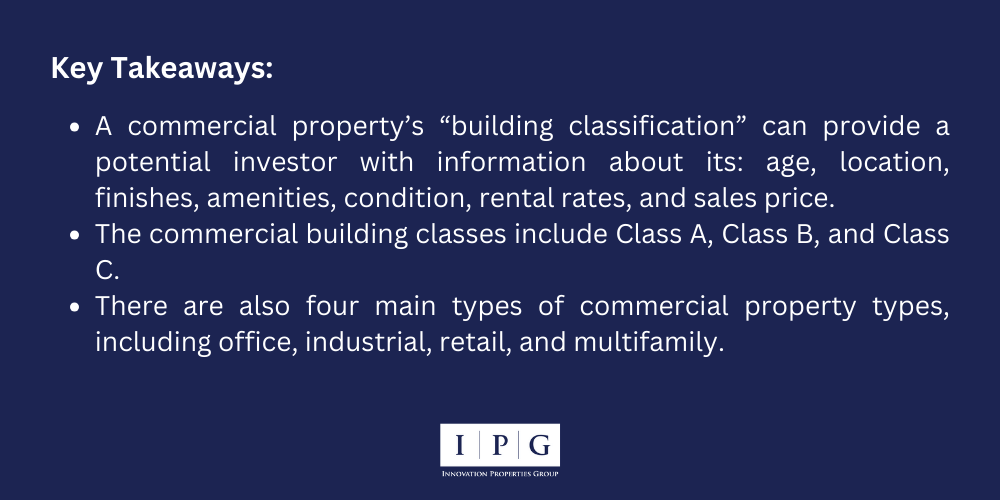You probably know by now that not all office buildings are created equal.
They are more than just structures – they’re categorized into Class A, B, and C, each representing a different level of quality, amenities, and location. This classification system is crucial for anyone navigating the commercial property market, from investors to business owners seeking office space.
These aren’t just alphabet labels; they are keys to unlocking the personality and potential of office spaces. Think of them as a compass guiding you through the landscape of commercial properties, each pointing to distinct features and opportunities.
From the high-end allure of Class A buildings, the balanced appeal of Class B, to the unpolished diamond that is Class C – we’ll explore what makes each class tick.
What are Office Building Classes in CRE?
In commercial real estate, office buildings are typically categorized into three classes – Class A, Class B, and Class C. These classes help in evaluating, leasing, and selling office spaces based on various criteria such as location, building quality, and amenities.

Class A Buildings
Class A office spaces are modern, state-of-the-art office buildings, often epitomized by the sleek high-rises in a city’s financial district. Here’s a detailed look at what sets these buildings apart:
- Newest and Most Advanced: Class A buildings typically include the newest properties in the area, equipped with cutting-edge facilities and technologies.
- Superior Construction and Location: These buildings are recognized for their high-quality construction and prime locations, often situated in the heart of the city or in highly sought-after suburban areas.
- Exceptional Management and Aesthetics: With top-notch management, these properties boast considerable visual appeal, from beautifully designed lobbies to impressive exteriors.
- Parking and HVAC Systems: They offer a high parking ratio and state-of-the-art HVAC systems, ensuring comfort and convenience for tenants and visitors.
- Advanced Security and Communications: Class A buildings are equipped with the latest in security and communications technology, providing a safe and interconnected environment.
- Best-in-Class Amenities: These properties often feature luxurious amenities, including cafes, valet services, and more, catering to the needs and comforts of tenants.
- Energy Efficiency: Class A buildings are designed with energy efficiency in mind, often incorporating eco-friendly features and systems.
- Prestigious Tenant Profile: Typically occupied by high-profile clients like renowned law firms and banks, these buildings hold significant prestige and status.
- Premium Pricing: Reflecting their superior features and locations, Class A buildings command the highest rental rates in their markets, often significantly above the area’s average.
Class A office spaces are not just buildings but symbols of corporate prestige and success. They attract businesses and investors who seek the very best in terms of location, facilities, and status in the commercial real estate market.
Class B Buildings
Considered to be a slight downgrade from Class A properties, Class B buildings are still worth a lot in the commercial real estate world. These properties offer many benefits like class A, such as professional management, good accessibility and quality tenants without the extra costs. Building Class B is a bit older, but still has good infrastructure and is well maintained.
Investors find Class B office space appealing because their value can be easily increased with some simple tweaks and upgrades, thus restoring their Class A glory once again. Class B office space is usually a little newer and a little larger. In the office market, the Class C buildings are mostly built in 1960, often with walk-ups or retail stores, and the Class B office space is generally developed after 1960 and until 1984, with several columns spaced around the floor, which makes it difficult to layout offices.
The floor sizes in Class B office space can be up to 10,000 sq ft, with elevators that work, ‘dated’ restrooms and HVAC systems that are usually not very efficient. Class B office space is usually leased in three to five-year terms, assuming that the business in the CLASS B building is growing and making money.
Here are the key characteristics of Class B buildings:
- Age and Condition: Class B buildings are typically older than Class A properties. They might be dated in terms of design and infrastructure but are generally well-maintained and functional.
- Location: While they may not be in the most prime areas, Class B buildings are usually in decent locations that are still accessible and attractive to a range of businesses.
- Amenities and Quality: The amenities in Class B buildings are good but not as luxurious or comprehensive as in Class A spaces. The building quality is above average, but the finishes and fixtures may not be the latest.
- Rental Rates: The rents in Class B buildings are typically lower than in Class A buildings, making them attractive to small or medium-sized businesses looking for good quality space without the premium price tag.
- Renovation Potential: Many investors see Class B buildings as good opportunities for investment and renovation. By upgrading these buildings, they can potentially be repositioned as Class A properties.
- Tenant Mix: The tenants in Class B buildings are often a mix of professional services firms, smaller corporations, and local businesses.
- Management: These buildings are professionally managed, though the level of service may be less comprehensive than in Class A properties.
Comparing Class A vs Class B Office Space
Class A office spaces offer modern architecture, prime locations, and extensive amenities, making them prestigious and highly sought after, but at a higher cost. In contrast, Class B office spaces provide good quality and functionality at more affordable rates, located in accessible and less congested areas, with fewer amenities. Choosing between Class A and Class B office spaces depends on the specific needs and budget of a business, balancing the desire for prestige and amenities with affordability and functionality.

Class C Buildings
Coming in the last place and considered to be the lowest classifications of office buildings and space is building Class C. These are older buildings (usually 20 years or older) which are located in less desirable locations and often require a lot of renovation and work.
Speaking from the point of architecture, Class C buildings are the least enticing and their infrastructure is outdated. As a result of that, these buildings have the lowest rental rates, are often targeted as re-development opportunities and take the longest time to lease.
With dedication and work, Class C properties might restore their building Class B status but are not likely to ever become class A (there is a very slim chance), largely due to their location.
Here’s an overview of their key characteristics:
- Age and Condition: Class C buildings are usually older, often more than 20 years old, and may require significant renovation and upgrades. They tend to have outdated infrastructure and may show signs of wear and tear.
- Location: These buildings are often located in less desirable or less convenient areas compared to Class A and B buildings. They might be situated in less developed neighborhoods or regions that are not considered prime commercial zones.
- Amenities and Quality: Class C buildings typically offer minimal amenities. The quality of these spaces is lower, with older fixtures and fittings and sometimes inadequate maintenance.
- Rental Rates: Reflecting their lower quality and less desirable locations, Class C buildings have the lowest rental rates in the market. This makes them accessible to startups, small businesses, or any business needing functional space without a high cost.
- Investment Potential: For real estate investors, Class C buildings can represent opportunities for redevelopment or renovation. By investing in improvements, these properties can be upgraded to Class B or even Class A status.
- Tenant Mix: The tenants of Class C buildings are often small, local businesses or startups working with limited budgets. These buildings can serve as an entry point for new businesses that cannot afford higher-class office spaces.
In summary, Class C buildings in commercial real estate cater to tenants and investors with specific needs and constraints. They offer functional space at lower costs and can be ideal for businesses that prioritize budget over location and amenities.
Which Building Classes Are the Best?
Nobody can decide which type of commercial office space is best suited for your needs, but you.
The answer to which one is the best really depends on what you’re looking for in a property. If you are an investor who can afford to spend money and time on renovations, then Class B or C properties might be the best fit for you.
If you are on the other hand, a small business that doesn’t need a space that offers much exposure, then go for Class C property.
Class A commercial property might make sense if you are a business that is focused on innovation and technology, and higher rent for all the extra amenities is a good investment.
Your mission, your finances and your needs play a crucial role in the decision-making process and choosing the right commercial office space.
All of the above explains why Tenant Representative brokers and Landlord agents have gotten more specialized and experienced in their job over the last 15 years. In order to excel you have to know all about your client’s needs.
Some buildings work better for certain types of tenants, medical and legal are good examples, and an experienced commercial broker, who knows his market and the owners and buildings within that market, should encourage a client to pursue one building over another in their building search or accommodation.
We make sure that the tenant is fully aware of all of the good and negative sides of the building considered, their owners and some property management questions.
No matter if you know exactly what you’re looking for or not, we will assist you in finding the optimal space for your commercial office and help you to understand the building classes of commercial real estate. Contact us today and see why our team has been successfully operating in San Francisco for a long time.



















